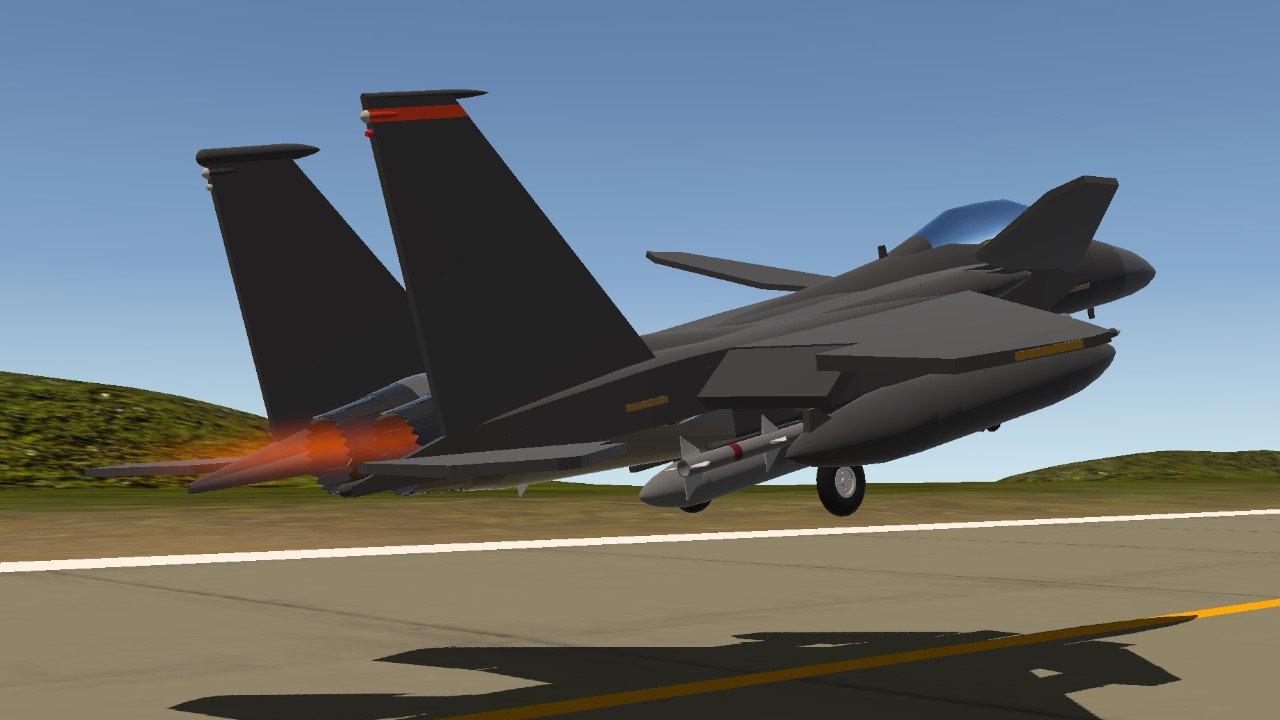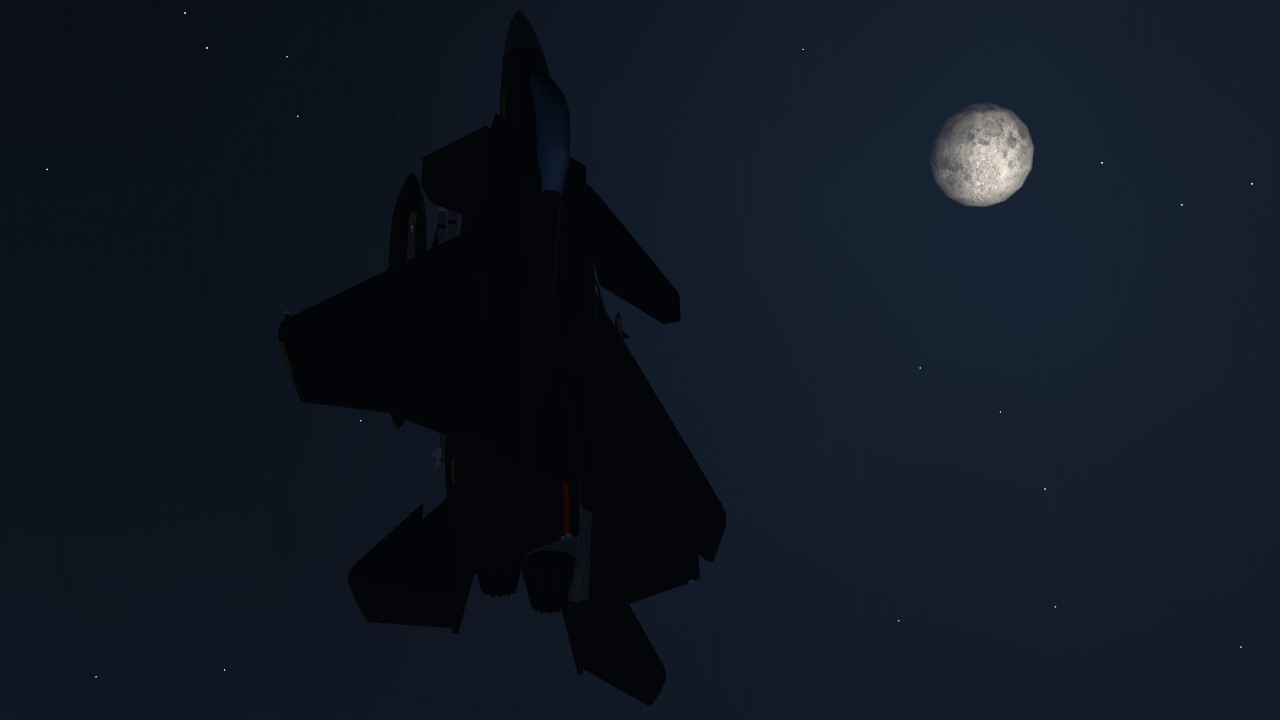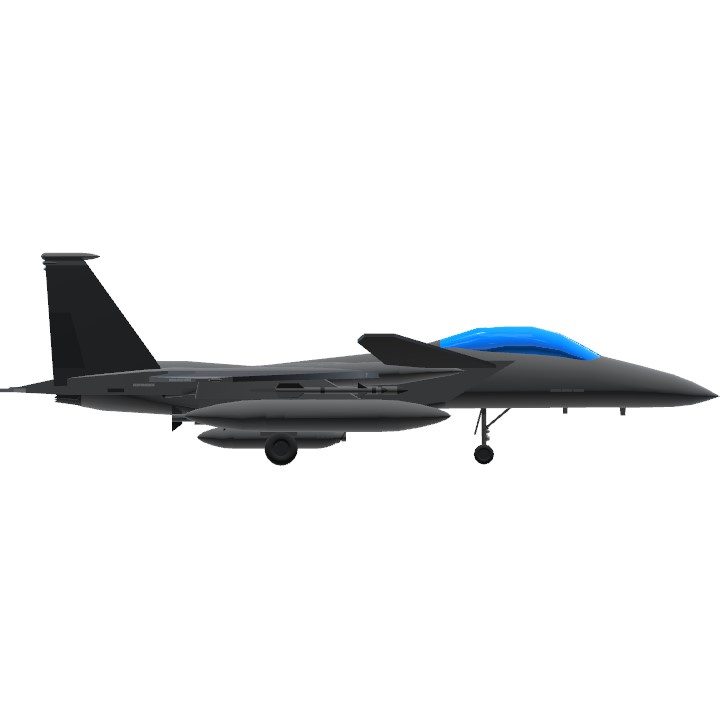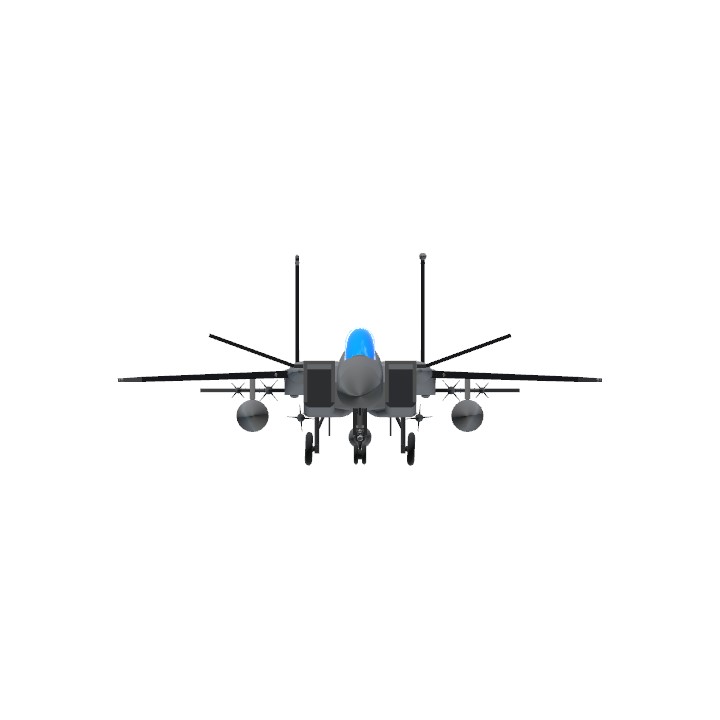F-15S Agile Eagle
-Lore-

In 1985, the Pulchriturian Royal Air Force (PRAF) aimed to explore ways to improve on their successful air superiority fighter & interceptor; the F-15 Eagle. With international rivalries growing slowly but noticeably since the end of the Gruneheimian Conflict of 1954, Gaia's previous major conflict, the PRAF predicted the need for military aircraft capable of using shorter, bombed-out runways, or shorter & rougher takeoff spaces in the prediction that airstrips would likely be targeted in a first strike. Pulchriturian interceptors were primarily in trouble, this being their F-15 Eagles, an aircraft unsuitable for short takeoff and landing distances.
So the PRAF came to the Pulchriturian Technical Institute (PTI)--a joint organization consisting of Pulchrituria's most successful engineering corporations which included the manufacturer of the Eagle--and commissioned for a special F-15D with modified avionics to allow the collection of flight data, a more-powerful pair of engines derived from the F-16 lightweight fighters, variable engine nozzles that allow for thrust vectoring up to 20 degrees in all directions, and front canards attached to the front-most sides of the fuselage just next to the variable intakes--sizable canards taken from the production line of the Pulchriturian Royal Navy's (PRN) F/A-18 Hornets.
The aircraft rolled off the assembly line by 1986 and was named the F-15 F-SCD (First-Strike Condition Demonstrator).
Years of research went by, with the PTI and PRAF finding takeoff distances reduced by 10-15% depending on conditions & weapon loads, landing/stopping distances reduced by up to 30%, and controlled flight at up to 85 degrees of AoA.
Within this period of research and testing, the aircraft's maneuverability in flight was tested and adjusted over time, proving to be more maneuverable in a dogfight than the production F-15's due to its greatly-improved maneuverability--provided by 3-D thrust vectoring & canards and an incredible thrust-to-weight ratio--and more potent in BVR fights due to its greater acceleration and turning capability. Improvements in flight performance only improved further as the PTI began their research in intelligent flight control systems, using the FCS of the PRAF F-16 as a baseline and applying it to the F-15 F-SCD
Due to this projected improvement in performance over the standard Eagles, the PRAF greenlit and commissioned a production variant of the F-15 F-SCD to be in production by 1996, equipped with the F-15E's radar, avionics--including software which allow for air-to-ground weapon compatibility--and compatibility for the CFT of the standard Eagles to allow additional fuel capacity for less drag than external tanks.
The aircraft came to be named the F-15S "Agile Eagle", seeing service for the first time in 2002, flown by PRAF 10 pilots & their trusted WSO's over Tanruil during the Three-Week War, wearing Tanruilian Air Defense Force F-15C liveries to assist Tanruil in their air and ground campaign against Natsik invaders.
The war ended with the Agile Eagles scoring a 31:0 kill ratio, with the PRAF flight crews left unnamed and the 10 disguised Agile Eagles being handed to the Tanruilians as a token of allegiance.
-Description-

With the boring part out of the way--meet the F-15S Agile Eagle, a fictional, supermaneuverable, multirole, twin-engined fighter based on the F-15 ACTIVE. New 3-D thrust vectoring and improvised canards ripped from the tail-end of an old Hornet allow for maneuverability far beyond the standard for Eagles, and shorter takeoffs & landings in case you have to takeoff from or land on the beaten path--all making up the capabilities of an F-15 ACTIVE that made it into production.
It wears the same paintjob as the dark grey Strike Eagles that came 11 years before its introduction, just to show how it was made on the same production line with many parts similar to its ground-pounding brother.
Using a 20mm M61A1 stuffed in a gunpod, AIM 9X's, and AMRAAM's, take advantage of the aircraft's otherworldly maneuverability both within and beyond visual range of bandits.
Or equip Mavericks & Paveway II's to show that even hostiles on the ground are unsafe from the Agile Eagle's speed and precision.
-Loadouts-
Current Loadout - 2x Drop Tank, 2x AIM-9X, 6x AIM-120C
Alt. Loadout 1 - Strike - 2x GBU-12, 4x AGM-65D, 4x AIM-120C, 1x Drop Tank
Alt. Loadout 2 - Clean
-Controls-
Normal [Throttle]/[Pitch]/[Roll]/[Yaw]/[LandingGear]
- [Throttle = 85% to 90%] Military Power
- [Throttle = 90% to 100%] Afterburner
[VTOL] Elevator Trim (Inverted)
[Trim = 0%] Auto Flaps, [Trim = 0% to +100%] Flaps Up Override
[FireGuns] Fire 1x 20mm M61A1 Vulcan
[AG1] Lights
[AG2] Reduced-Stability Mode (RSM)
[AG8] Master Arm
Hardpoint Activation Groups
[AG3] Wing Hardpoint 1B Drop Tank Release
[AG4] Wing Hardpoint 1A AIM-9X Manual Release
[AG5] Wing Hardpoint 1C AIM-120C Manual Release
[AG6] CFT Hardpoint 1 AIM-120C Manual Release
[AG7] CFT Hardpoint 2 AIM-120C Manual Release
-Cameras-
[Cam1] Targeting Pod View (Alt. Loadout 1)
-Author’s Notes-
- Fuel and gun ammo is unlimited.
- On takeoff, I recommend 60% trim with 100% flaps. Get to around 270 km/h and give taps for the pitch to avoid tail striking and generate lift (For keyboard users).
- To perform a cobra maneuver, slow to 600 km/h, throttle to military power/afterburner (if you haven’t already), activate RSM, and pitch up. Simply bring the nose back down and release pitch to level out.
- To perform a kulbit maneuver, slow to 400 km/h, activate afterburner & RSM, and pitch up. You must be level and around the height of your kulbit or you will lose yaw stability. As you reach 270 degrees of rotation during the kulbit (nose-down, or 3/4's of the rotation finished), release pitch and let the fly-by-wire stabilize the plane to level out.
- To perform a falling leaf maneuver, slow to 600 km/h, activate RSM, and roll & pitch up simultaneously to initiate the spin. Then, once the spin initiates, you can use yaw to control spin speed and the pitch to control the nose for more or less angle. To recover, release yaw and pitch up to generate lift and speed until you begin flying straight again. Or deactivate RSM and let the plane guide itself back to stability. Warning: You may be significantly lower in altitude than where you started.
-Updates From Last Post-
- Adjusted fly-by-wire for additional maneuverability, especially in the spectrum of high-alpha rolling (Little to no more yaw caused by roll thanks to additional roll authority caused by the TVC and canards).
- Added PitchRate FT to reduce the amount of pilot input needed to control the nose and to allow easier control within and recoveries from post-stall maneuvers.
- Added auto-flaps that activate when the landing gear is deployed.
- Two additional AGM-65 Mavericks for the Strike loadout which replace the two AIM-9X Sidewinders, to further sell that you should not be dogfighting with this loadout.
-Credits-
- @OkaNieba - for the original F-15E Strike Eagle I modified to create this aircraft.
- @ReinMcdeer - for the original F-15C from which the F-15E was derived, the canards of the F-15 ACTIVE, the F-15C in its standard loadout used in the Lore screenshot, and the SU-30SM used in the Description screenshot.
- @Guyfolk - mainly for the aircraft I used (or tried to use) as a reference for flight performance, relative to the performance I was going for.
Specifications
Spotlights
- ACEOFFICERS 5 months ago
- CrestelAeronautics 5 months ago
General Characteristics
- Predecessor F-15 STOL/MTD (F-15S Agile Eagle (V0))
- Created On Windows
- Wingspan 42.9ft (13.1m)
- Length 63.8ft (19.4m)
- Height 19.0ft (5.8m)
- Empty Weight N/A
- Loaded Weight 45,249lbs (20,524kg)
Performance
- Power/Weight Ratio 1.281
- Wing Loading 34.3lbs/ft2 (167.3kg/m2)
- Wing Area 1,320.6ft2 (122.7m2)
- Drag Points 1850
Parts
- Number of Parts 319
- Control Surfaces 10
- Performance Cost 1,690







Credits:
@OkaNieba
@ReinMcdeer
@GuyFolk
@GuyFolk thank you!
This Eagle is indeed agile.
Good job.